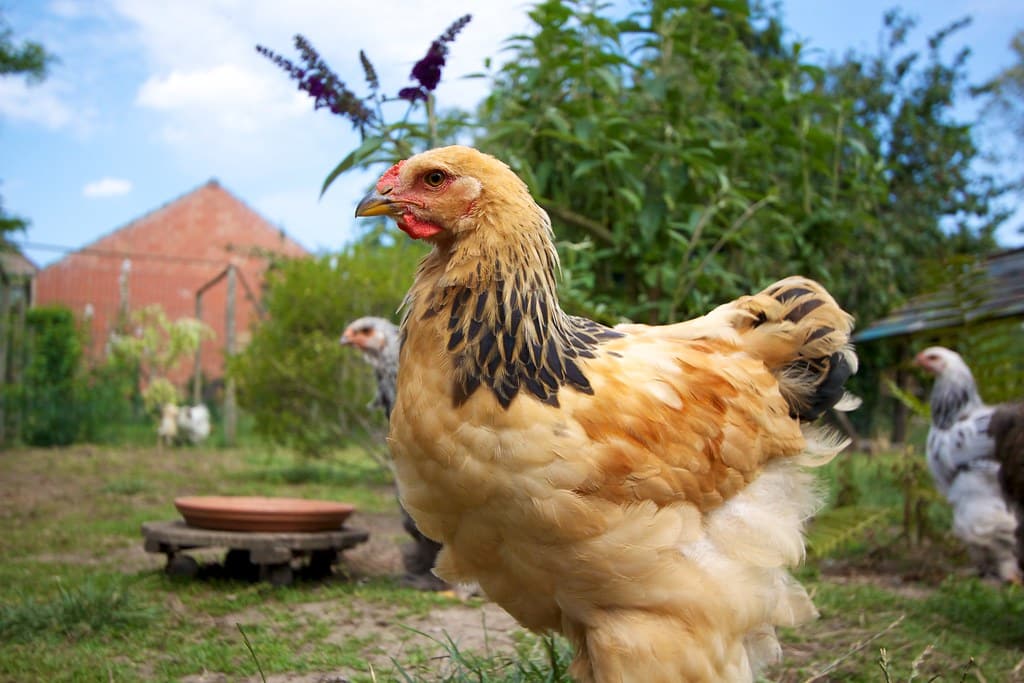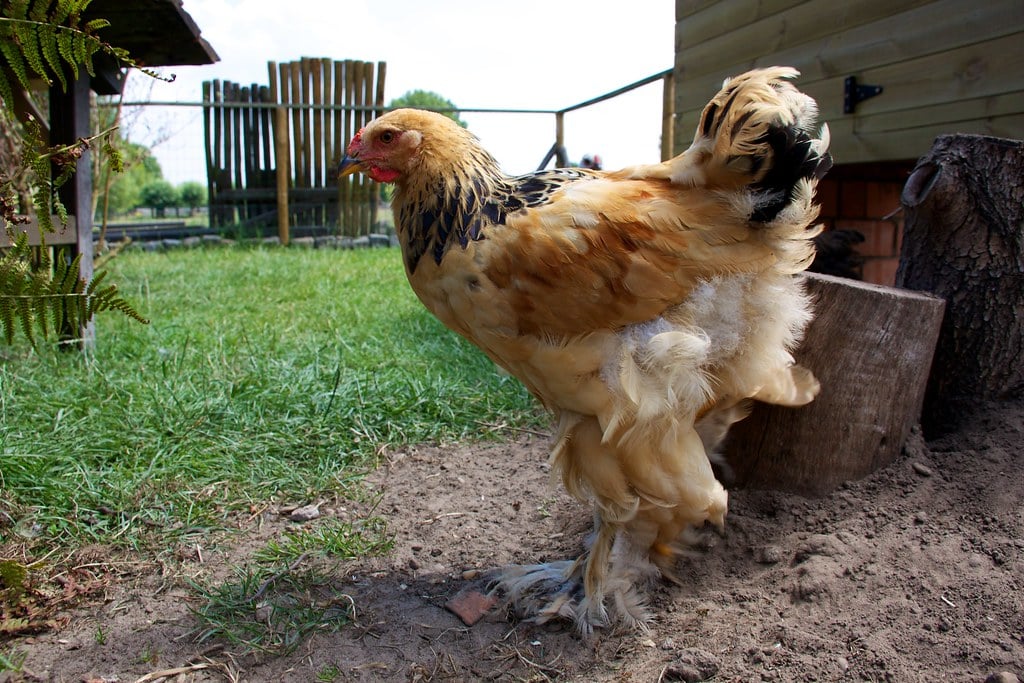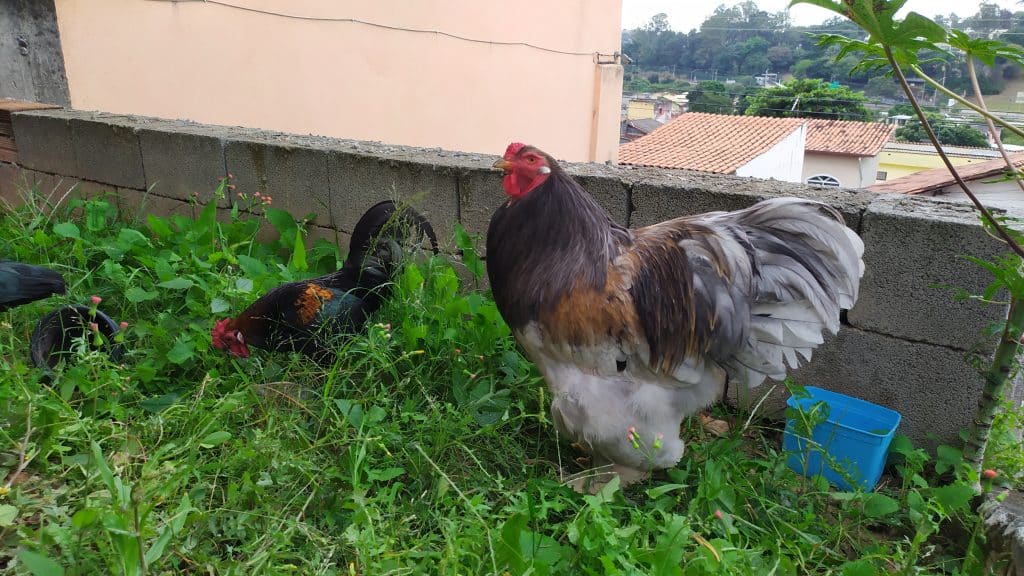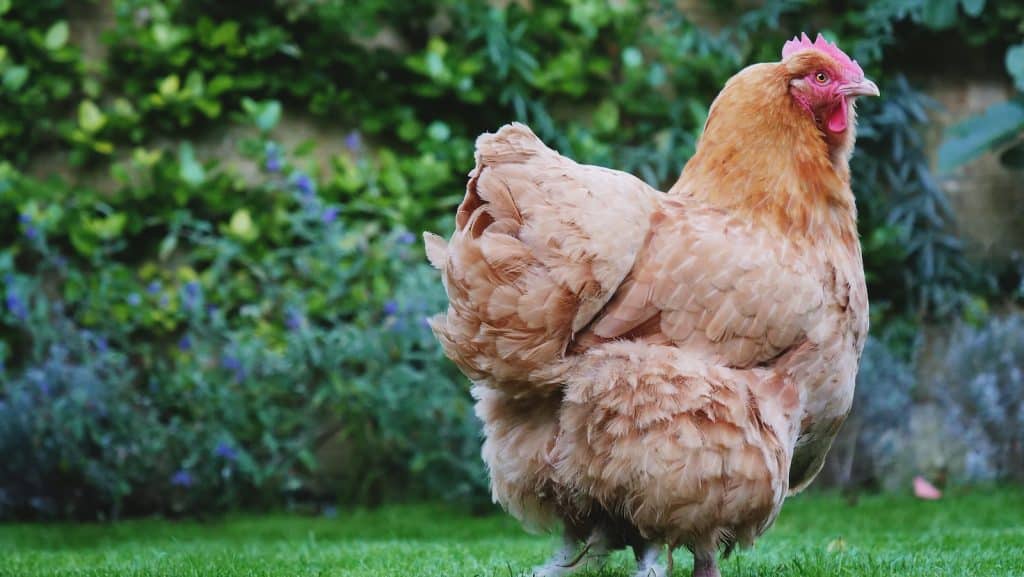
The Brahma chicken, a versatile chicken breed, is essential for backyard farmers. The Brahma chicken, also known as the “King of All Fowls” and the yard’s “gentle giant”, is a beautiful breed of poultry you can raise for meat or eggs.
This chicken is a great choice for backyard chickens because of its friendly disposition and attractive outlook. It is important to determine if these chickens will be a good fit for you.
This in-depth guide will help you make an informed decision about adding these fowls before you add them to your flock.
Here are some quick facts about Brahma Chicken
| Scientific Name: | Gallus gallus domesticus |
| Family: | Phasianidae |
| Care Level | Intermediate |
| Temperature: | Warm |
| Temperament: | Peaceful, calm, gentle, friendly, and docile |
| Color Form: | 16% protein and layer feed to layers, 18% proteins for hatchlings and chick food for hatchlings, as well as supplements such calcium, omega 3, insects and worms |
| Lifespan: | 5-8 Years |
| Size: | 30 inches tall, males weighing 12 lbs and females weighing 10 lbs. |
| Diet: | 16% protein and layer feeds to layers, 18% proteins for hatchlings and chick food for hatchlings, as well as supplements such calcium, omega 3, insects and worms |
| Minimum Habitat Size: | Chickens: 5-8 square feet |
Brahma Chicken Overview

Brahma chicken, an Asiatic bird breed, is named after the Brahmaputra River. While many people disagree about the origin of the Brahma chicken, there are some sources that suggest it was developed in America by crossing the Shanghai birds from China and the Gray Chittagong birds from Malaysia. Brahma has a distinctive head and pea-comb due to the breeding.
Brahma is considered a heritage bird by the Poultry Association because it was developed before the 20th century. American breeder George Burnham sent the Gray Shanghaes from America to England in 1852 to Queen Victoria. This was before English breeders developed the first dark Brahma breed.
After that, the American Poultry Association Standard of Perfection published the first publication on the light and dark varieties of chicken. In its 1874 first publication, the American Poultry Association Standard of Perfection included both light and dark varieties. Later, the Buff Variety was published in 1942.
From the 1850s to the 1930s, this chicken strain was used as a table bird in America. They were soon exotic fowls, which people kept as ornamental, meat- and egg-bearing birds.
The breed’s slow maturation rate meant it lost its popularity to other rapidly-maturing chicken varieties. The Livestock Conservancy recently called it a “recovering variety” as they have gradually become a popular fowl for backyard farmers.
What Does Brahma Chicken Price?
Before purchasing Brahma chicken breeds it is important to evaluate your budget, including the cost of shelter and feeding. Braham chicken varieties can be affordable but they will require extensive habitats because of their size and higher food budget.
Brahma’s price greatly depends on the chickens’ age, sex, color, and demand. If they show birds, the cost of light, Buff, and dark chicks is usually between $3-$5 and $5.
Depending on the quality, prices for adolescents are $7-12 and $15-25 respectively. You might pay more for other Brahma colors.
The Typical Behavior and Temperament
Brahma fowl species is a great choice for those who are looking for more personality in chickens than just eggs. Brahmas are intelligent, sweet, and calm with a laid-back disposition.
These birds are gentle and kind, and they love children. They love being held and are trusting. They are friendly and easy to handle due to their large size and inability to fly.
Brahmas’ flock is also calm, docile, and peaceful making them a great fit for both urban dwellers as well as beginners.
Appearance and Varieties

Appearance
The Brahma bird is large with a deep, long, and broad body. It can also stand up to 30 inches tall, which can make it intimidating.
Males are taller than their female counterparts and can weigh in at 12 pounds (5.5 kg). Females can weigh as much as 10 pounds (4.5 kg).
The distinctive feature of Brahma is its small pea-comb and overhanging “beetle eyebrow” on the forehead. It has medium-sized wattles and reddish-brown eyes. Short tails, yellow shanks, feet, red earlobes, and yellow beaks.
The magnificent bird is tall and strong, with a large stature. It has long feathered legs and a narrow V-shaped shape if viewed from the sides. These birds are not capable of flying despite their strong wings. Brahma chickens mature slowly and may take up to 18 years to reach full maturity.
Coat
This chicken species is known for its thick, dense, and heavy plumage. It’s also well-known for its toughness, making them a hardy bird. Brahmas are characterized by dense, tight, and soft feathers that reach their legs and to their hind toes. This makes them appear larger than they actually are.
Color
Brahma chickens can identify with three official colors: dark, light, and buff. These birds can also be found in other colors such as White, Blue and Black, Partridge, or Barred.
Dark Brahmas are black with silver highlights and black spots. They also have a black-striped carriage. The body, wings, and breasts of the Dark Brahmas are made from grey with black patterns.
Light Brahmas have a grayish tint to their feathers and are typically white-feathered. The saddle area has black stripes and the tails have a few white feathers.
The buff Brahmas, on the other hand, have a similar coloration as the light Brahma, but with brown feathers. Farmers love the Buff because of its brown hue.
How to Care for Brahma Chicken
Brahmas are a great option if you’re thinking of adding them to your flock. It is important to be aware that they might have some unique characteristics to the other breeds. Here are some special considerations when keeping Brahma species of chicken.
Enclosure/Cage
Brahma fowls, which are larger than average chickens, require a bigger enclosure or cage. Brahmas, despite their size, can survive in small spaces. Brahmas are foragers and prefer larger, more open spaces.
When rearing these species, the first thing you should do is give them protection from predators. You will need to cover their runs and make sure they are protected from extreme weather.
Brahmas are very heavy so it is important to make sure that your runs and coops can accommodate them. If you place your chickens in smaller spaces, they can display anti-social behavior like picking and pecking.
For chickens in coops, a 2-foot fence is sufficient to hold them in place. To prevent your chickens from flying, you can give them 8-12 inches of roosting space.
Bedding
These birds can be fed regular chicken bedding, such as straws, pine shavings, cedar shavings and grass clippings. They can also use paper shreds or shredded leaves. Your flock should have a solid foundation and be easy to clean.
Temperature
Brahmas are resilient and less susceptible to frostbite and cold climates because of their large masses, dense-feathering and small pea comb. These species are not as heat-tolerant as other breeds and should be kept in hot areas. To prevent heat strokes, you should maintain high temperatures in hot summers.
Lighting
In winter, ensure that your chicken coop receives at least eight hours of sunlight per day. Brahma hens should have at least 14 hours of daylight to enable them to lay eggs.
Are Brahma Chickens compatible with other pets?
Brahmas can be large but are easily bullied by other chickens. They are gentle and soft and won’t respond to being attacked.
If you have to keep Brahmas, make sure they are surrounded by other friendly chicken breeds and pets such as cats. To prevent loneliness and harassment, it would be a good idea to pair it up with another Brahma bird.
Because they are large and can’t escape danger when faced with danger, these birds need protection from aggressive cats and dogs. If you have to keep Brahmas with other pets, you should train and prepare them beforehand.
Begin a relationship slowly and monitor their interactions. Do not force them into a relationship if they are not compatible. Keep the Brahma chickens clear of bullies.
How to feed your Brahma Chicken
These fowls can be great foragers. They love to chase worms and bugs around the yard. They can’t forage enough to survive so feeding them should not stop when they are free-range. You should ensure that your flock receives plenty of other feeds.
They can consume up to a third-pound of chicken feed per day. It can be difficult to ration their feeds as they are heavy feeders so it is best to give them free food to cut down on your feeding costs.
Brahma chickens are large and stocky and need lots of calories, water, and feeds to maintain their appetites and good health.
It is important to keep your chickens healthy. Chicks can be introduced to an 18% protein chicken starter.
Because they can be aggressive and bully one another when hungry, it is better to keep your flock happy and full. You can also supplement your feeds with mealworms like Happy Hen Treats, hens, omega-3, and feeds rich in calcium, such as FLYGRUBS Black Soldier Flea Larvae Chicken Feed.

How to Keep Your Brahma Chicken Happy
Brahma fowl species can be tough, but owners need to take care of them. These issues can be minimized by making sure that the enclosures are safe and can withstand extreme climates.
While Brahmas are able to withstand winter harshness, feathers can prove problematic. Because their feathers can get wet from walking on snow, mud, and ice, it is important to keep the enclosures dry.
If you don’t stop them quickly, dirt and moisture can freeze to form small mud balls on the chicken’s feet. This can cause frostbite and other health problems.
To get rid of any feathery feet or buildup, it is a good idea to inspect your flock and wash them with warm water. You should also check for mites, lice, and other parasites to remove thick feathery plumage.
Your chicken should be allowed to roam free and have plenty of freedom. Because of their large size, these breeds are more susceptible to bumblefoot than other species. Cornstarch or styptic Powder can be used to treat the bleeding feet of your chickens after their feet have pulled off, snagged, or become stuck on surfaces.
Breeding
Brahmas aren’t very common due to their slow growth. Brahmas lay their first eggs at 6-6 months of age, whereas other breeds start at 4 or 5 months. This breed is not a prolific egg layer.
Brahma hens lay an average of 3-4 eggs per week of medium-large eggs and approximately 150 eggs each year. The chicks hatch in 21 days. After that, the Brahma chicken provides heat until the hatchlings are old enough for them to regulate their body temperature.
A brooder box is essential for chicks. It should contain fresh water, chick food, and bedding. You should provide a brooder box that is i8 inches tall and with half the space for each chick in their first few days. After two weeks, you can increase this space to one square foot per chick.
Mother Brahmas are great brooders. However, owners should provide heat sources at a temperature of below 100 degrees Fahrenheit to hatchlings for the first five days.
The temperatures can be lowered by five degrees each week until the chicks reach independence. It can take nine months for Brahma chicks to grow a full plumage.
Are Brahma chickens suitable for you?
Are you looking for large, friendly, affectionate, and affordable chickens to add to your garden? Brahma chickens are the right choice for you. The calm, easygoing nature of this chicken breed makes it a wonderful pet or asset to your family.
Even though their large size can seem overwhelming to new parents and children, they are easy to fall in love with. You may need to take extra care when caring for them as they are large birds that require more food and larger nests.
You can live with your chicken as long as you love them, give them plenty of food, and provide warm protection.
What makes Brahma chicken unique?
Brahmas are first and foremost incredibly resilient chickens. They also lay a lot of eggs for their size, laying up to 200 big, medium-brown eggs every year. They are considered a great winter layer, laying the majority of their eggs from October to May.
Do Brahma chickens lay eggs on a daily basis?
The Brahma chicken lays a good amount of eggs every year, usually approximately 130 to 150 eggs. As a result, a hen will normally lay three brown eggs every week
A Brahma hen can sit on how many eggs?
Good breeds for 20 eggs include Brahma – excellent moms with plenty of space for up to 20 eggs!
What is the biggest breed of chicken?
The Giant of New Jersey The Jersey Giant chicken is the world’s largest purebred chicken. Males range in weight from 13 to 15 pounds and stand 20 to 26 inches tall. The hens weigh 10 to 12 pounds and are 15 to 20 inches tall. The Black is one pound heavier than the White on average.
Are Brahma roosters loud?
Although there are always exceptions, Brahma chickens are generally a calmer breed. “Despite their size, Brahmas are mild. They know how to behave even when crowing: they produce little noise and are not fanatical growers.
Which chickens lay the most eggs?
Here are the five chicken breeds that are most likely to produce the most eggs. Leghorn in white. In their first year, these gorgeous birds may produce up to 300 big white eggs…. Rhode Island Red…. Ameraucana…. New Hampshire Red…. Sussex…. Goldline (Hybrid)… Plymouth Rock…. Golden Comet.
Which chicken breed lays the most eggs in the Philippines?
Layers of Lohmann When they’re 72 weeks old, it’s one of the best-laying chickens in the Philippines, producing 290 to 320 eggs every year. Lohmann brown hens lay 14 to 19 weeks sooner than other breeds and can lay up to 380 eggs per year at their peak.
What kind of chicken lays 350 eggs every year?
Chickens from Isa Brown These chickens are capable of laying 300-350 eggs each year. That’s nearly one for every day of the year. Many Isa Browns begin laying before most other breeds. A healthy Isa Brown hen can begin laying as early as 16 weeks.
What are the top five egg-laying hens?
Bovans Browns are among the top chicken breeds noted for their consistent laying. Hylines. Australorps. Leghorns. Orpingtons. The Reds from Rhode Island.
Is the Brahma chicken the biggest?
The Brahma chicken originates in America and typically weighs approximately 12 pounds. A Brahma chicken is the heaviest chicken known (more on this below! ), yet on average, the breed is somewhat smaller than the Jersey giant, which comes in first.